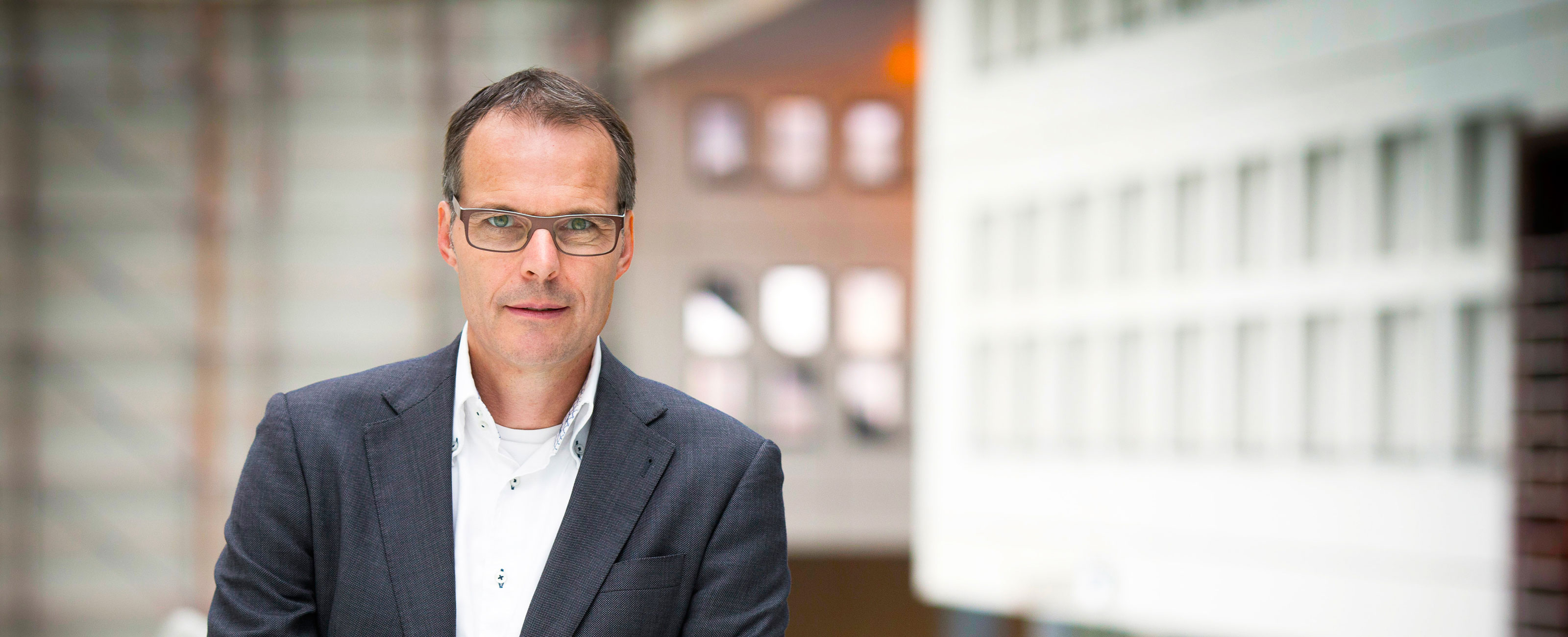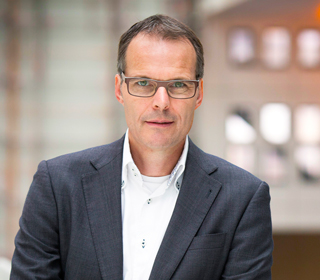Menno Riemersma on the new Erasmus MC
'Relationship with EGM is a strategic partnership'
“You need an architect when developing healthcare buildings. Not to make the exterior beautiful, because that’s not the most important aspect. An architect is more a strategic partner who helps to think about logistics, processes and content.”
These are the words of Menno Riemersma, Director of the Intregral Building Programme and responsible for property at Erasmus MC in Rotterdam. This large new building completed in late 2018 attracted plenty of press attention and even a visit from the King. A milestone, but “a hospital is never finished. We’re already working on new projects,” explains Riemersma, who sees property largely as a strategic asset.
The view from the twenty-first floor of the Erasmus MC building in the heart of Rotterdam is phenomenal, even on a drab morning in spring. Clinical patients at the academic hospital enjoy the same panoramic views: nursing units are located on the upper floors, while outpatient clinics and operating theatres are located on the lower floors. “The higher you climb, the calmer it gets. And the better the view of course!”, explains Menno Riemersma enthusiastically. “The Erasmus MC is referred to as ‘the white city in the city’. We very much want to strengthen connections with the city around us. And we want more interaction with the neighbouring museum district and park. That’s one of the ambitions for the future.”
Strategic choices
Riemersma’s focus is on optimizing processes, he explains. Buildings have to facilitate and support those processes. “Healthcare property is complex, because it’s not a liquid asset. They are customized structures for very specific processes, certainly when it comes to an academic hospital where learning and research facilities play a big role. At the same time, property and its exploitation is a major item on the balance sheet of a hospital. In short: each choice you make concerning building or renovating has implications and has to be viewed in the longer term.”
New insights are always good. I see an architect more as a strategic partner that you want working alongside you
Riemersma has a team working on that every day within the Erasmus MC organization. And he also has a circle of external advisors. “New insights are always good. I see an architect more as a strategic partner that you want working alongside you. Aesthetics are important of course, but I’m more interested in spatial insight, understanding hospital logistics and optimizing processes. In that sense, EGM gives you lots of experience.”
Flexibility and standardization
All buildings can now be accessed from the passage on the first floor – a layout that is clear to everybody who visits or works at the Erasmus MC for longer or shorter periods. It feels like a spacious, continuous atrium with a modest selection of shops and spots for meetings and encounters. Thousands of people walk through this passage every day – as many as fifteen thousand on busy days, explains the property director.
It is also the route to the best coffee in the whole complex, which Riemersma has no difficulty in finding. “I actually don’t occupy a fixed workspace. There are various places where support staff can work flexibly. That flexibility is vital in a constantly changing organization.” A lot of standardization has therefore been achieved in specific spaces, says Riemersma. For example, in the outpatient clinics and operating theatres. “So that capacity there can be distributed across various units.”
Architectural conscience
EGM has been involved with the Erasmus MC building complex for over twenty years. Bas Molenaar took the lead initially, and he was followed by Willemineke Hammer as project architect. “The architect is the architectural conscience of the building,” Riemersma points out. “And the engineering consultant also plays a key role in hospitals. I think that investment in building equals investment in installations. Good collaboration and trust among the team is therefore extremely important.”
People have a sense of identity with the place where they work or live. It’s very tangible. Fascinating
For Riemersma and his team, preparing the various parts of the project is an important task: “We have to create the context within which the architect can do his or her work.” As soon as the project is ready for execution, Riemersma moves onto the next project. “I’m not directly involved in the construction phase. That’s a job for the project managers on my team, but it’s still great to watch the progress. No doubt that’s down to my technical background.” And once the building is completed, it belongs to everybody. That’s what Riemersma has noticed. “Nursing staff and doctors also start calling it ‘their’ building. People have a sense of identity with the place where they work or live. It’s very tangible. Fascinating.”
Caroline Kruit, journalist and publisher, interviewed Menno Riemersma in May 2019
Project: Erasmus MC

